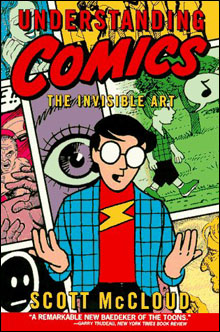Picking the brain of Scott McCloud, the world's reigning comics genius
By IAN A. MAISEL | June 22, 2006

Scott McCloud's Understanding Comics |
Scott McCloud writes about cartoons in a comic book format, and has become one of the world’s premiere comics theorists. In his books, he draws himself as a professorial narrator who invites the reader onto the page to check out his ideas about cartoon history and the psychology of what happens when we read comics.His first book about cartoons, Understanding Comics, was published in 1993 and was promptly added to the syllabus of every cool college professor across the country. Seven years later he drew Reinventing Comics. It was a visionary book, but by his own admission it was also too ambitious: a vessel for every theory he’d ever had about cartoons, Reinventing became an intellectually bloated history manual and was greeted with mixed reviews.
This fall McCloud will publish a new book, Making Comics. He’s a kind-hearted and fascinating guy, and our interview quickly spiraled into a three-hour love fest. Here are a few excerpts.
What’s hard for you to draw?
There are a few things cartoonists will tell you are just plain hard to draw. Bicycles are hard to draw. You really need to look at a bicycle in order to draw a bicycle. You think you know what it looks like, alright? Until you actually sit down to draw it, then you totally – you completely choke on it.
All those gears and everything!
Yeah, it’s the gears and also the struts don’t really follow any logical pattern that you can remember. So you just have to look. But these days with Google’s image search you can — you just find out what anything looks like. It doesn’t matter. In the old days when I was starting out in the ’80s, everybody had their collection of National Geographics and we would go out and buy all these stupid magazines and you know cut out picture and think, “Oh there’s a koala bear — I might have to draw a koala bear someday!” And you know you’re never ever going to have to draw a koala bear and you’re just wasting your time with your scissors and your eight-and-a-half by 11 paper and your glue sticks sticking these things down and spending hours –
You’re just avoiding work!
Yeah, just avoiding – right! Avoiding work. I actually love drawing what my peers dismissively call “backgrounds” but what I like to call environments. Just sidewalks and cityscapes and skies. Fields of grass and everything. Or “the rest the world” is another way I like to refer to it. Because one of the problems with a lot of comics art today is that many comics artists learn how to draw people and they just stop there. And they become what Will Eisner called “slaves to the close-up.” They try to close in on the characters as much as possible because they know if they keep their camera angles tight they can keep their backgrounds down to a few lines. I think the European tradition is much more conscientious about drawing the full range of subjects. And that’s why I think there’s a very rich tradition of comics and of world building in European comics. I think that’s something we could learn from.
 Related
Related:
Sifting the trash heap, Globalized, The Golden Age of Comics, More 
- Sifting the trash heap
There’s an image in an old Warlock comic book by Jim Starlin that sums up a lot of the peculiar, shared pleasure of reading comics.
- Globalized
This season, there are two best buys when it comes to bang for your comic-book buck.
- The Golden Age of Comics
Ever wondered what would happen if the famed Simpsons ’ Comic Book Guy held a master’s in literary criticism?
- The Mostly Unfabulous Social Life of Ethan Green
Eric Orner, creator of the underground comic strip on which this film is based, has said that he’s always envisioned the strip as an animated sit-com. Watch the trailer for The Mostly Unfabulous Social Life of Ethan Green (QuickTime)
- Fantastic Four: Rise of the Silver Surfer
Even as a 10-year-old Marvel Comics fan, I knew that the Silver Surfer was a dumb character.
- Excerpts: Art Spiegelman's Breakdowns
Comic excerpts from Art Spiegelman's Breakdowns .
- Reading roundup
This fall’s regional literary scene will see abstinence and desire, ghosts and dykes, convicts and Christians, toxic water bottles and yummy food.
- Interview: Daniel Clowes
"If you had told me then that there would be cute girls coming to comic conventions in 15 years, I would’ve told you you were out of your mind."
- Terror 'toonist
Earlier this month, syndicated cartoonist Matt Bors found a new fan in none other than Salim Hamdan, the man tried and convicted for once having been Osama Bin Laden’s driver.
- Robert Crumb at MassArt
R. Crumb's Underground at MassArt
- Iron Man
Though a Marvel Comics fan, I never thought much of Iron Man.
- Less

 Topics
Topics:
Books
, Celebrity News, Entertainment, Media, More  , Celebrity News, Entertainment, Media, Books, George Clooney, Dick Cheney, Graphic Novels and Comics, Book Reviews, Movie Stars, Joe Pesci, Less
, Celebrity News, Entertainment, Media, Books, George Clooney, Dick Cheney, Graphic Novels and Comics, Book Reviews, Movie Stars, Joe Pesci, Less 